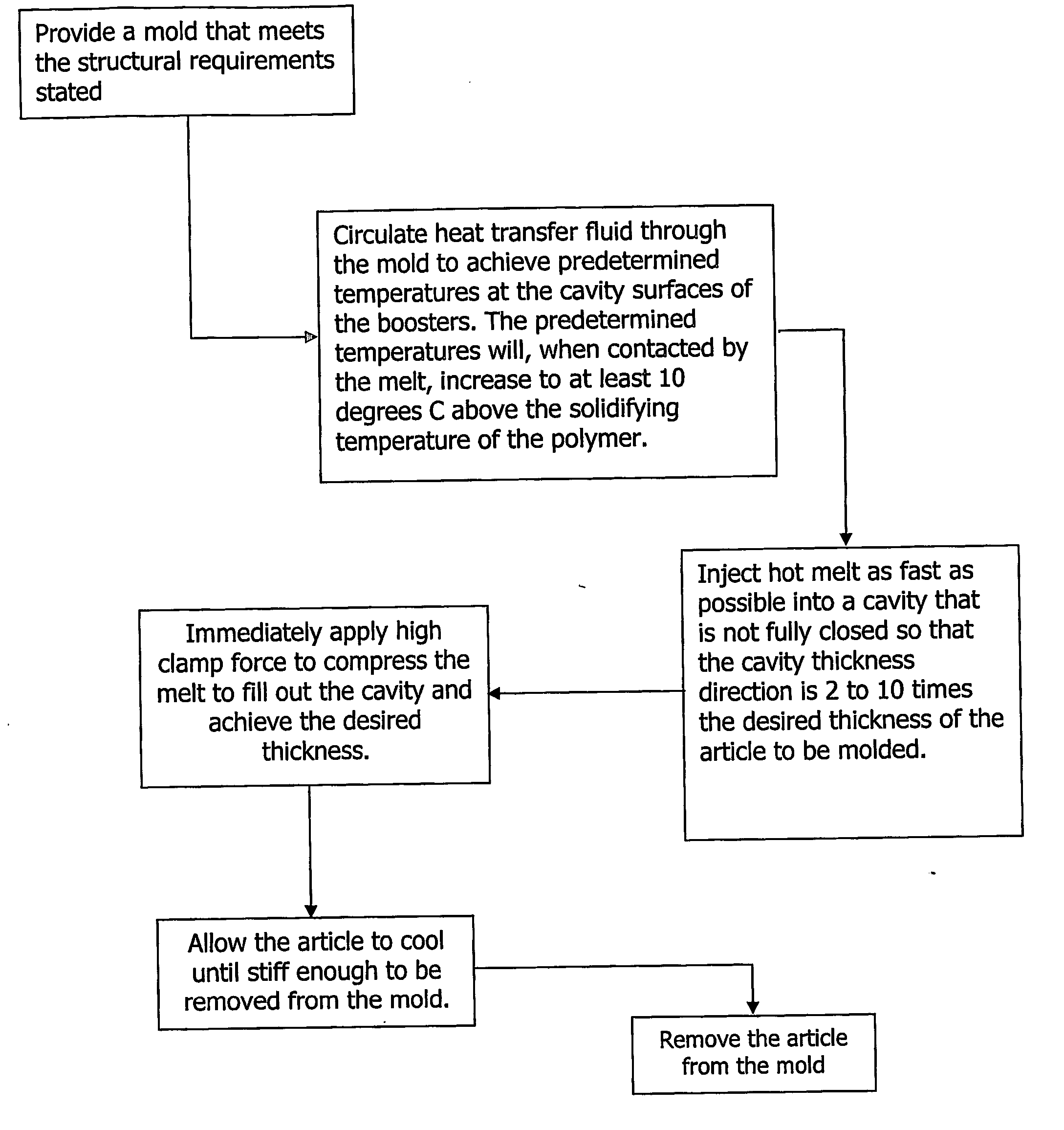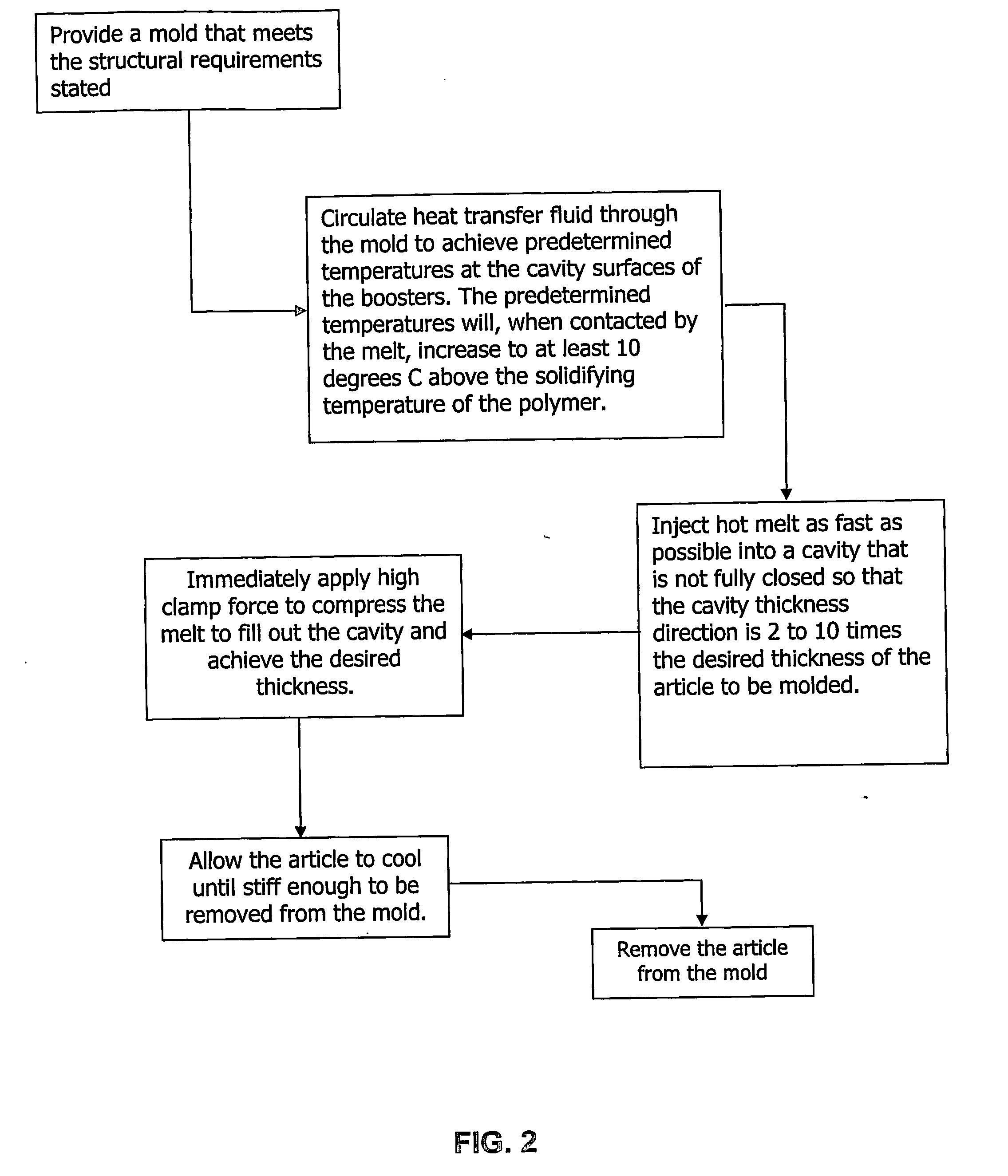Mold and process for making a very thin wall article
a molding process and very thin wall technology, applied in the field of plastic molding, can solve the problems of affecting the strength of molded parts, the speed at which they can be produced, the energy requirements of temperature control and other factors, and the inability to meet the requirements of molten materials, so as to facilitate the flow of molten materials and reduce the injection pressure. , the effect of increasing the thickness of the flow path
- Summary
- Abstract
- Description
- Claims
- Application Information
AI Technical Summary
Benefits of technology
Problems solved by technology
Method used
Image
Examples
first embodiment
[0050] In accordance with a preferred embodiment of the invention, there is disclosed in FIG. 1 a simplified cross-section of a first embodiment mold 1 for manufacturing a very thin wall optical disc. This embodiment is discussed in connection with a moving mold part 10 and an opposed mold part 20, it being understood that such movement is a relative matter and either or both of the mold parts can be movable. The disclosed embodiment is more or less symmetrical across the cavity, each side having thermally insulating temperature boosters and temperature control fluid passages. It should also be understood that the preferred symmetrical arrangement is only an example and it is also possible to embody the invention asymmetrically, e.g., with temperature boosters on one side only.
[0051] In the embodiment of FIG. 1, a relatively movable side element 10 of mold 1 comprises moving side temperature booster 11, moving side die 12, center fluid passages 13, 14, and 15, and edge fluid passage...
second embodiment
[0091]FIG. 3 shows a simplified cross-section of a mold 2, in a second embodiment that is useful for molding optical discs. A moving-side element 10″, moving-side temperature boosters 11″, and moving-side die 12″. The purposes, requirements, and suitable materials for boosters 11″ are the same as those for boosters 11 of FIG. 1, mold 1. Although not shown in FIG. 3, booster thicknesses can be different at different locations to promote more uniform cooling.
[0092] Moving-side die 12″ provides structural support to boosters 11″. The functions, and requirements for die 12″ and fluid passages 23″, 24″, 25″, and 26″ are the same as those for die 12 and passages 13″, 14″, 15″, and 16″ of mold 1 of FIG. 1. Fluid passage 19 is part of the center fluid circuit. Other thermal means for temperature control stimuli for the die may be used.
[0093]FIG. 3 also shows a stationary-side element 20″. Element 20″ comprises a stamper 32, stationary-side temperature boosters 21″, and stationary-side die ...
third embodiment
[0098]FIG. 4 shows a simplified cross-section of mold 3, a third embodiment that is useful for molding an optical disc article. Element 10′″ and 20′″ of mold 3 have boosters 11′″ and 21′″ that define at least a part of the surfaces of cavity 17′″. Booster materials manufacturing and assembly requirements were identified under the description for mold 1 of FIG. 1. Boosters 11′″ and 21′″ are shown thicker towards the cavity outer edges to illustrate a design that helps overcome the greater heat loss and reduced melt contact time at the outer edge and is suitable for molding an optical disc. For example, a mold for manufacturing a 0.1 millimeter thick optical disc surface layer may have a booster that is 1.0 millimeter thick at its inside diameter and 3.0 millimeter thick at its outside diameter to keep the inner portion from overheating and unnecessarily extending the cooling period and molding cycle times. Generally, the thickness may be uniform or thinned or thickened at various loc...
PUM
| Property | Measurement | Unit |
|---|---|---|
| Thickness | aaaaa | aaaaa |
| Thickness | aaaaa | aaaaa |
| Length | aaaaa | aaaaa |
Abstract
Description
Claims
Application Information
 Login to View More
Login to View More - R&D
- Intellectual Property
- Life Sciences
- Materials
- Tech Scout
- Unparalleled Data Quality
- Higher Quality Content
- 60% Fewer Hallucinations
Browse by: Latest US Patents, China's latest patents, Technical Efficacy Thesaurus, Application Domain, Technology Topic, Popular Technical Reports.
© 2025 PatSnap. All rights reserved.Legal|Privacy policy|Modern Slavery Act Transparency Statement|Sitemap|About US| Contact US: help@patsnap.com



